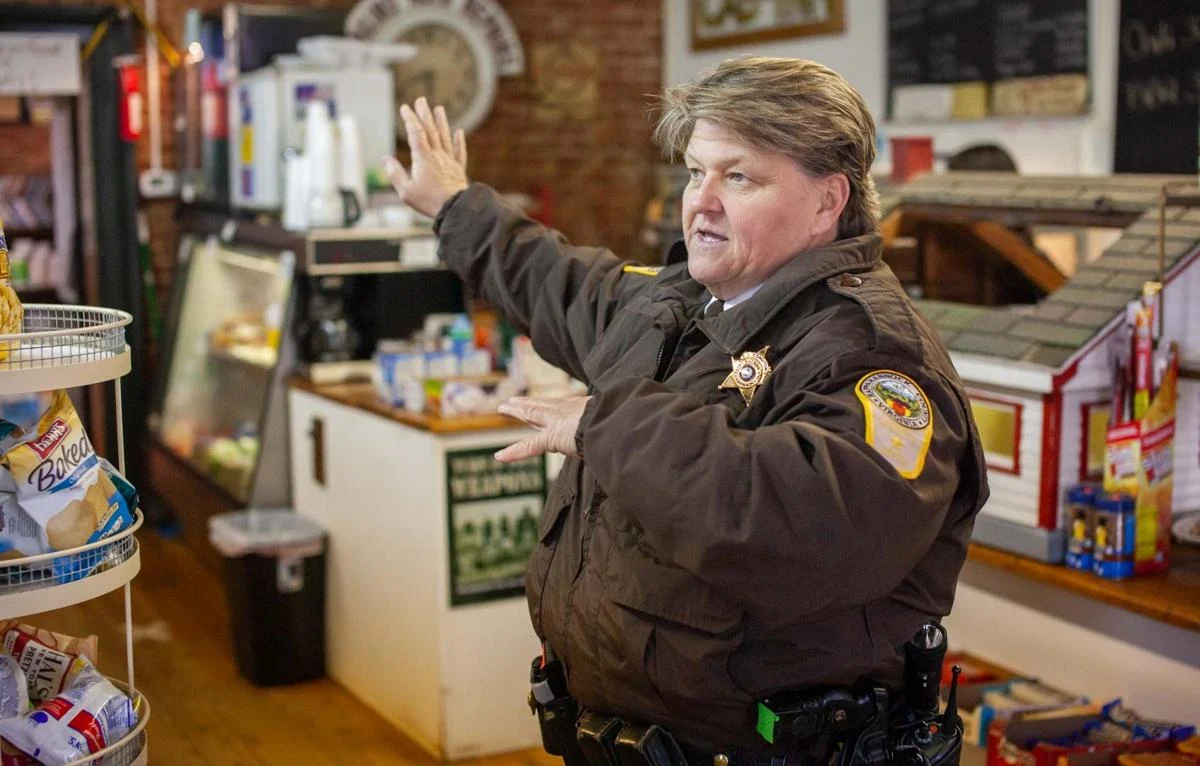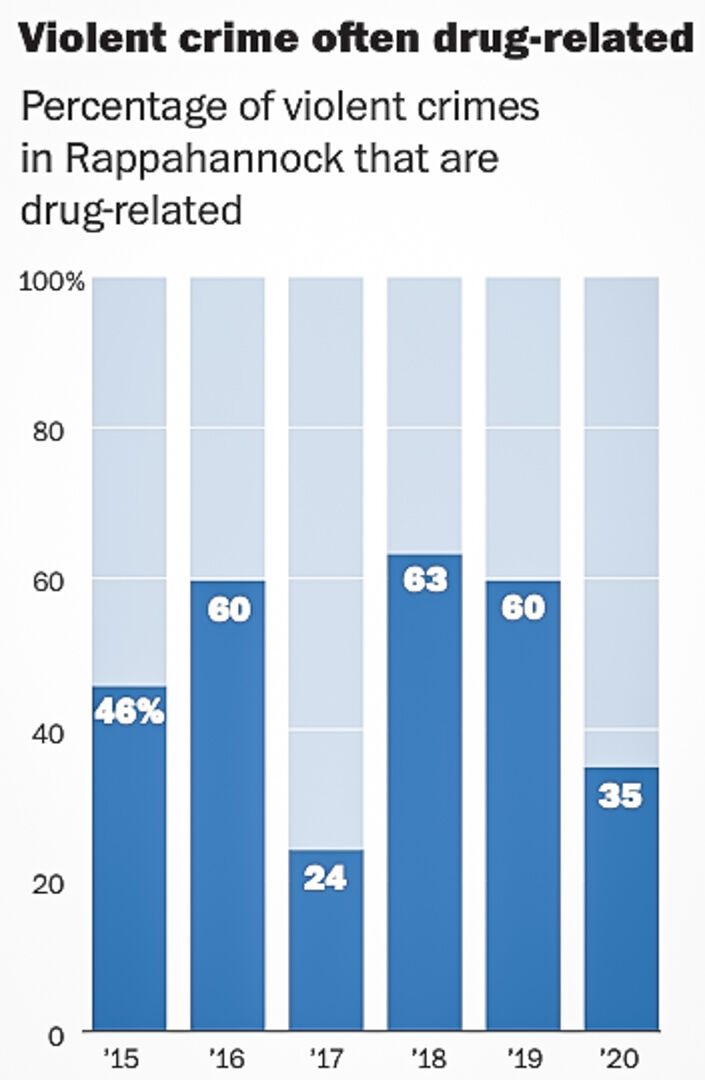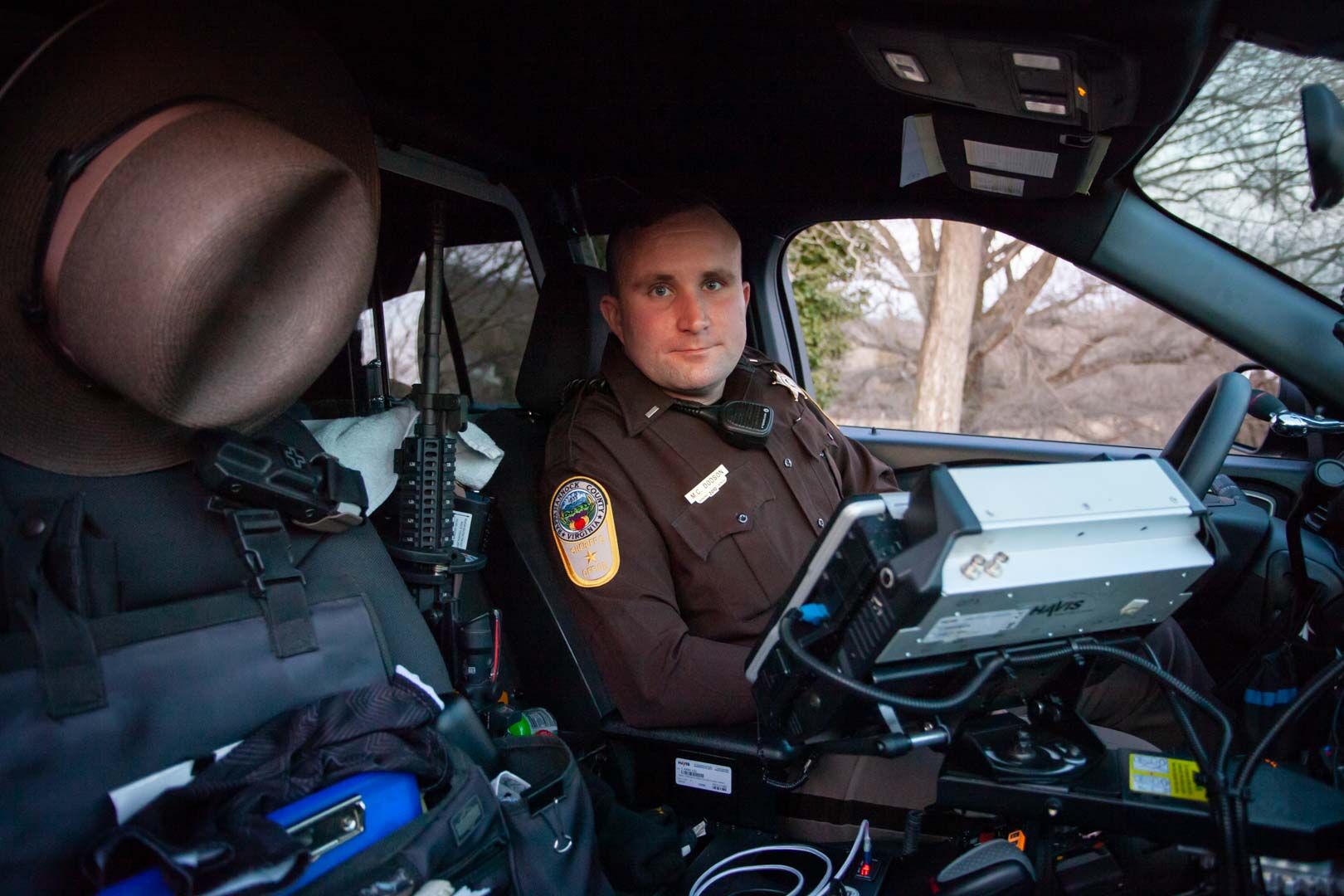‘Drugs are everywhere’
But county consistently has had among the lowest violent crime rates in Virginia
A Rapp News/Foothills Forum Special Report

“A little exciting, a little scary,” Sheriff Connie Compton said of the high-speed pursuit she participated in last year. (Photo/Luke Christopher)
Rappahannock County is blessed with one of the lowest serious crime rates in Virginia. So what worries Rappahannock County Sheriff Connie Compton?
“When you ask about crime in the county, one of my biggest concerns is drugs,” Compton said. “You know, 20 years ago, probably the biggest drug you had to worry about was marijuana. But now you have heroin and meth. And they are more and more potent.
“There are some people who don’t believe it’s here,” she said, “but drugs are everywhere.”
Between 2015 and last year, the Sheriff’s Office made 245 arrests related to drugs and narcotics, or roughly 45 percent of all arrests that fall in the “violent crime” category.

(Graphic/Laura Stanton)
Data for that period, supplied by Sheriff’s Office Lt. Janie Jenkins, shows drug-related arrests peaked in 2018-2019. For 2018 they represented over 63 percent of all violent crimes in the county, and nearly 60 percent for 2019. Since then, drug arrests have tapered off.
Property crimes — such as arson, burglary and larceny — account for the bulk of arrests in the violent crime category.
“Breaking and entering larcenies have gone down,” said Compton. “What helps is that people have put cameras on their houses, and they have alarms, so that’s helped [keep those kinds of crimes down] a lot, too. In that way, the community is helping us as we are helping the community. Everybody is working together.”
Crime data for Virginia’s 95 counties show that in recent years Rappahannock consistently has had among the fewest arrests per 100,000 population for violent crimes, including murder, drugs and aggravated assault. The ranking is similarly low for property crimes, including burglaries, larcenies and vehicle thefts.
But Rappahannock registered in the middle of the pack for drug arrests as recently as 2017.
It’s one thing to talk about statistics and another to experience crimes up close and personal, as law enforcement officers do every day.
One such incident happened at the 211 Quickie Mart on Lee Highway in November 2020 when, after rampaging through the store, a man with a knife attacked deputy Chris Ubben, cutting the officer’s pants. The man was tasered by another officer and charged with multiple serious offenses, including attempted malicious wounding of a police officer and assault on a police officer.
Compton herself was involved in a high-speed chase last year through Rappahannock, Culpeper and Fauquier counties, the driver crossing over Route 211 at times and driving against traffic. He eventually lost control of the vehicle and ran into a tree.
“A little exciting, a little scary,” Compton said of the pursuit. “You don’t know what the other vehicle will do, you don’t know what your own vehicle will do. You have other people traveling on the road,” in this case driving west on Route 211 with a stolen vehicle coming east toward them at a high rate of speed.
“You have to [pursue] in the safest manner you can,” the sheriff said. “Fortunately, nobody got hurt.”
Editor’s note: In addition to interviews with the Rappahannock County Sheriff’s Office, data for this story is drawn from sources including the Virginia State Police, the Virginia Sheriff’s Association, and the Virginia Department of Criminal Justice Services Criminal Justice Research Center.
Although these data sources may collect and analyze information differently, every effort has been made to ensure that the statistics quoted in this series accurately reflect the nature of law enforcement in Rappahannock and other counties. Meanwhile, the Rappahannock News has a pending Freedom of Information Act (FOIA) request with the Virginia State Police seeking available data about traffic stops by the Sheriff’s Office.
Anatomy of an arrest
Although no one was arrested during the March 5 ride-along, Lt. Cody Dodson explained arrest procedures using a domestic disturbance as an example.
“If a family member is physically assaulted in a domestic situation, Virginia law requires that one of the parties be identified and arrested,” he said. “It is the job of the officer on the scene to determine the primary aggressor by interviewing and taking statements from all the subjects on the scene. It can get complicated, and frankly emotional, especially when there are a number of people involved. It is especially challenging if there is only one officer able to respond.”
These are the procedures usually followed for a domestic disturbance:
-
Once the officer on the scene evaluates the evidence and determines probable cause, the primary aggressor is taken into custody.
-
The suspect is transported to the Sheriff’s Office, where the officer does a background check for any criminal history and finishes preparing the complaint.
-
The suspect and the charging officer then appear before a magistrate. In Rappahannock County this procedure is conducted by video conference with magistrates in either Loudoun or Fauquier counties.
-
Based on the officer’s criminal complaint, the magistrate will determine if there is probable cause to issue an arrest warrant.
-
Once an arrest warrant is issued, the magistrate will go into a bond hearing and determine whether the suspect should be released or sent to the regional jail in neighboring Warren County. The magistrate may allow the suspect to pay bail in order to be released from jail. The magistrate determines the amount based on factors like the severity of the alleged crime and the likelihood the defendant may flee rather than show up for trial. Suspects unable to afford bail may turn to bail bond companies that provide a “surety bond” making them liable for the full bail amount if the defendant fails to show for trial. These companies charge a fee that typically is 10-15 percent of the bail amount.
Dodson explained the aftermath of an arrest for a domestic situation can be a long, drawn-out process sometimes requiring protective orders issued for victims. If children are involved the social services department is notified.
For a traffic stop involving a possible charge of Driving Under the Influence (DUI) of alcohol, the driver is administered roadside tests that can detect impairment.
Three standardized tests are typically administered:
-
“Horizontal Gaze Nystagmus” test moving a stimulus like a pen back and forth across the face to detect involuntary twitches in the eyes.
-
“Walk and Turn” test where subjects are asked to walk in a straight line, turn around, and return.
-
“One Leg Stand” test where a subject is asked to stand on one leg for 30 seconds.
The driver may be asked to take a Breathalyzer (BPA) test on the scene but has the option to decline. “I’ve pretty much made up my mind as to the level of impairment using the three standardized tests, so the BPA is not usually key in making a determination,” said Dodson. “If a driver is taken into custody, they are required to take a more sophisticated blood alcohol content (BAC) test at the station. Those results are sent directly to a state forensics lab in Richmond for later use in judicial proceedings.”
With drivers on narcotics, impairment may be harder to detect. An advanced test is often used to determine an individual’s internal “time clock.” The suspect is asked to close their eyes, tilt their head back and estimate the passage of 30 seconds. If they have taken a stimulant or depressant, their response will likely speed up or slow down. Other tests measuring finger dexterity and eye movement are also used.
Once a narcotics-impaired driver is taken into custody, the suspect is transported to a hospital emergency room for a blood draw to determine narcotics in the bloodstream. Following that, the same arrest procedures are followed as in a DUI case.
On patrol
‘There is no such thing as a routine traffic stop’
On Friday, March 5, this reporter spent several hours on a “ride-along” with Lt. Cody Dodson, Sheriff’s Office patrol division commander, during his 6 p.m. to 6 a.m. shift.

Lt. Cody Dodson setting out for patrol. (Photo/Luke Christopher)
The Ford Explorer looked roomy from the outside. But inside seating was cramped, the front cabin crammed with assorted communications gear, radar equipment and an AR-15 semi-automatic rifle. The trunk was filled with two “go bags” which contained medical supplies to treat gunshot wounds in active shooter situations, a 12-gauge shotgun, a .22-caliber rifle needed to put down injured animals, extra ammunition magazines, crime scene “totes” for evidence collection, photography equipment, flares, traffic cones, a kit for unlocking vehicles, a first aid kit, and an AED automatic defibrillator.
Although Lt. Dodson was well prepared for most any kind of situation, it would be a relatively quiet Friday night — four traffic stops, one minor accident with no injuries, and an injured animal in the road.
Deputies on duty
Dodson and two other deputies on duty, Chris Ubben and Tommy Sisk, were responsible that night for patrolling all 266 square miles in the county. On weekend nights three patrol cars are usually on duty, unless someone calls in sick. “We are often spread thin and just too small a force for each of us to cover specific zones,” said Dodson. “Rather, we travel areas of our choosing with no set pattern, mostly on secondary roads, and monitor each other’s whereabouts.”
During their 12-hour shift, deputies are required to spend several hours conducting “selective enforcement,” police jargon for traffic enforcement. We spent time at two stakeouts, one on Viewtown Road and the other on U.S. 522 in Sperryville. Four vehicles were pulled over for speeding, two at each location. Only one driver, who was traveling 21 mph over the speed limit, received a summons. The other three, although traveling in excess of the speed limit, were given warnings.
Why?
“When it comes to traffic stops officers still have discretion when issuing a ticket,” said Dodson. “If the driver has a good record, is polite, or has a credible excuse, I take that into account. A lot also depends on the time of day and traffic volume. If a stream of cars is going by at 10 miles an hour over the speed limit, I won’t stop them. But if one is going 15 miles an hour over, I’ll pull it over.”
He added: “There is no safety in numbers” for speeders. Radar has become so sophisticated it can identify a car in a group that is moving faster than the rest.
Discretion also depends on the type of enforcement being conducted. “If I’m looking for DUIs and it is midnight with a few cars coming by, I’ll stop someone going 10 miles per hour over the limit,” he said. “Will I write them a ticket? Probably not. But if it turns out to be a DUI, that’s a different matter. We don’t exercise discretion for DUIs, or drivers impaired by drugs.
“Our number one priority is to respond to calls from dispatch to protect the people who call in, and number two is to keep the roads safe as possible from DUIs, narcotics and dangerous driving behavior.”
Nothing is routine

Lt. Cody Dodson during a traffic stop earlier this year. (Photo/Bob Hurley)
Two months ago, a police officer in Page County was fatally shot during a traffic stop. The assailant shot the officer before he could get out of his patrol vehicle.
“There is no such thing as a routine traffic stop,” said Dodson. “That’s one thing I drill into our new deputies during training.”
The lieutenant explained that every traffic stop is different. “Your intuition can tell you a lot,” he said. “Things can go bad in a matter of seconds so you can never let your guard down.
“Until you deem otherwise, you have to approach it as if that person is going to kill you. Our number one goal, aside from protecting the public, is to go home.”
As a regular reminder of the danger he faces, Dodson always leaves a distinctive marking on any stopped vehicle when approaching the driver’s side. “If something happens to me and the driver takes off, there will be evidence that I pulled him over,” he said.
Asked about the risks and rewards of the job, Dodson said: “We have a great team and we look after each other. We don’t make a ton of money doing what we do. We do it because we want to.”
‘What’s your emergency?’
Inside the Sheriff’s Office nerve center
Step into the vestibule of the Rappahannock County Sheriff’s Office and peer through the thick Plexiglas window into the department’s nerve center: The dispatch office, a tiled floor space about the size of a bedroom.
Inside, 24 hours a day, seven days a week sit two employees before desk-to-ceiling arrays of computer screens. The dispatchers, civilian staff rather than sworn law enforcement officers, take emergency and other calls, monitor the whereabouts of deputies and fire and rescue personnel, and generally watch over the well-being of the county.
On the Saturday evening that this reporter observed the operation, Sheila Walter and Brandon Stroupe were just starting their 12-hour overnight shift. At shift changes (which occur at 6 a.m. and 6 p.m.) there is a flurry of activity as deputies signing off duty tell their reporting-for-duty colleagues of incidents that occurred earlier and situations that still need attention. There’s also bantering, teasing and gossip-sharing — signs of camaraderie among sworn officers and the civilian dispatchers.
This evening, the staff still mourns the tragedy of the previous week when a Page County deputy was killed during a routine traffic stop. Stroupe posts a notice on the bulletin board of another death: Charles (Charlie) Hawkins, chief and longtime member of the Castleton Volunteer Fire Department. Stroupe honors the fallen chief by broadcasting the notice to deputies and fire and rescue companies.

Division Commander, Janie Jenkins, in the Communications Center (Photo/Luke Christopher)
Shortly after the shift change, things settle down. Stroupe and Walter enter information from traffic summons and criminal activity reports left by the deputies on the prior shift. “We do paperwork when we’re not busy,” says Stroupe, who is three months into his tenure as a Rappahannock County dispatcher. A nine-year veteran of the Luray Volunteer Fire and Rescue Company, Stroupe also spent three years as a Page County Sheriff’s Office dispatcher.
Walter, too, is an experienced emergency responder. A resident of Amissville, she worked as a full-time dispatcher at the RCSO from 1984 to 2014, when she retired. Later that year she came back as a part-timer. She also volunteers at the Amissville Volunteer Fire and Rescue Company.
The office is quiet this weekend night except for a few calls about a possible fire in the Flint Hill-Huntly area. When calls come in, computer screens at both desks show Google Earth images of the area where the calls are from, as well as the name, address and phone number of the caller. Walter takes one and asks if the caller is near the site of a controlled burn reported hours earlier. If so, she reassures the caller that the smoke is likely from that source. Residents burning brush and debris are asked to notify the Sheriff’s Office as a courtesy. Computer screen icons show the locations of those burns.
Routine dispatch tasks include checking in with deputies. “We keep track of officers both on and off duty,” says Walter, adding: “Their radios transmit signals.” Stroupe notes that dispatchers also make status calls to officers every five minutes. “At midnight, we do roll call,” he says.
“We’re not very busy tonight,” says Stroupe. “I like when it’s quiet because it means no one’s hurt or injured, and everybody’s getting along. Sometimes I find it selfish when someone says ‘I want to be busy.’ It means that someone is hurt.”
“When it’s busy, the time goes by quicker,” says Walter.
Stroupe adds, “Some people may not know how much [law enforcement personnel] care. They only hear the bad things about law enforcement. I assure you, everyone in this department cares deeply about the community.”
When a call comes in
When a 911 call comes in, one of the dispatchers answers the phone with “what’s your emergency?” They ask the caller’s name and nature of the emergency, and log the information into a computer.
The second dispatcher sees the information in real time on another computer and sends the call to the fire or rescue company closest (or most available) to the reported emergency. A large screen in the center of the office’s cluster of computers carries graphics telling the dispatchers the availability of companies and equipment in Rappahannock and surrounding counties.
Other phones and computer screens link the dispatchers to Virginia and federal crime databases. Within seconds, Stroupe and Walter can respond to a deputy’s vehicle license tag check with the year, make, and model of the vehicle; tag expiration date; and if the owner has any outstanding arrest warrants. A master list, with data going back to 2002, keeps track of every call that comes into the office.
Stroupe says the office has the ability to rouse volunteer firefighters and emergency medical technicians through seven dedicated siren tones. Each tone signals a different fire and rescue company, so that volunteers of that company can know if they are needed.
Dispatchers wear wireless phone sets, so even if they are away from the computers they can still respond to calls immediately.
“We’re like everyone else,” said Stroupe. “If we’re not busy, we get drowsy, so we get up, walk around, maybe stand outside for some fresh air. But we are always connected. ”









